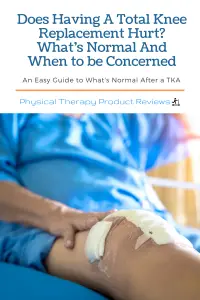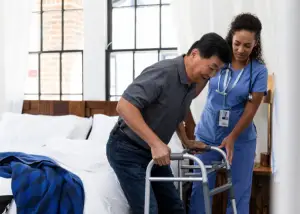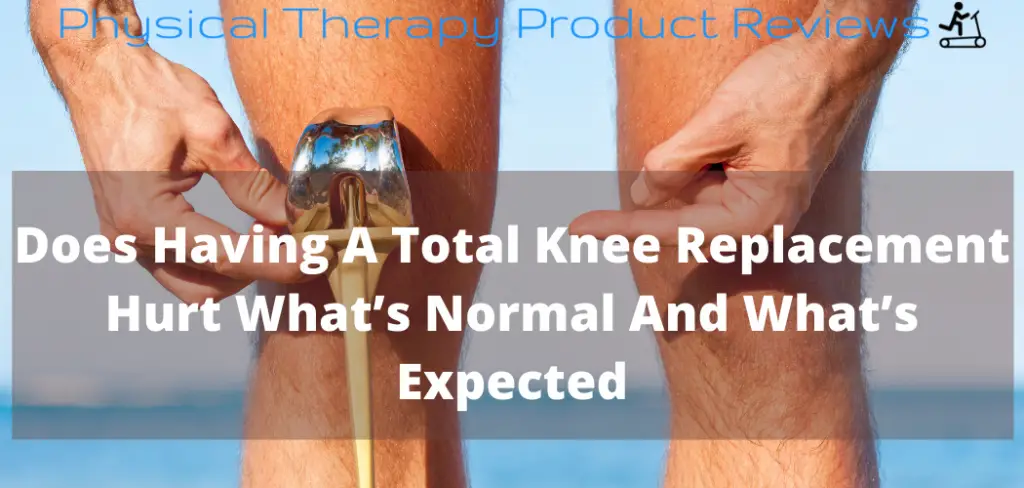 Many people wonder if having a total knee replacement hurts. The answer is yes, but there are many ways to treat the pain caused by this surgery. We’ll review when the pain is most severe, what causes pain to increase, and what you can do to make the pain levels manageable.
Many people wonder if having a total knee replacement hurts. The answer is yes, but there are many ways to treat the pain caused by this surgery. We’ll review when the pain is most severe, what causes pain to increase, and what you can do to make the pain levels manageable.
In the United States, there are approximately 250,000 total knee replacements performed each year. This is about 900 per day or 60 every hour. This means for those considering a knee replacement surgery because they have plenty of company and should not be afraid to talk about what will happen during and after the procedure to know what to expect.
Does Having a Knee Replacement Hurt?
Yes, there is an expected amount of pain after a total knee replacement from the surgery. However, the amount of pain varies for each person. Some people rate the pain no higher than 3-4/10, while others consistently report levels at 7-8/10.

The pain is generally most severe 3-4 days after surgery and can last up to 2 weeks before it gradually decreases. Pain typically lasts 3-4 months after surgery, but in some people can last up to a full year after surgery.
There are ways to combat the pain, which include medication, modalities, and exercises.
Why Does a Knee Replacement Hurt?
In a knee replacement surgery, the ends of both the Tibia and the Femur where arthritis has accumulated are sawed off and replaced with a metal prosthesis. This means that there is pain from not only the bones being modified but the soft tissue (muscles, tendons, and ligaments) get damaged during the surgery too.
Pain after a Knee Replacement comes from 3 sources, and they are all active at once:
The surgery itself – If you haven’t watched how a knee replacement is performed then you should. It will explain a lot about why you are having pain.
Healing After Surgery – Swelling, bruising, bones healing, and muscles repairing themself –
Recovery – You DO NOT want a stiff knee for the rest of your life, so you must start working on Physical Therapy and gaining back range of motion.
What Makes the Pain Worse After a Knee Replacement Worse?
Many things can make the pain worse after a knee replacement. Some factors are adjustable, and some you may not be able to do much about.
Inactivity
Being sedentary is one of the worst things that you can do after knee surgery. The knee will stiffen up, and the swelling with increase. You’ll quickly notice that you feel better after short walks and doing general range of motion to help prevent the knee from stiffening up.
Getting Behind on Pain Medication
It’s much easier to stay ahead of pain levels than to try and catch up to pain. For the first 2 weeks, try and take the pain medication as prescribed and gradually taper off. You’ll know when you can start to increase the time between doses.
Doing More than You Should
Even though we want you to stay active, this does not mean that you should go back to your regular chores and work. Make sure you take it easy while also keeping the knee mobile.
Other Factors That Can Increase Pain Levels
- Obesity
- Smoking
- Diabetes
- Neuropathy
When is the Pain Worst After a Knee Replacement?
The pain is typically worse 2-4 days after surgery. This is when the anesthesia has worn off, and the swelling has started to settle into the joint. The pain will remain reasonably high over the first 1-2 weeks. It gradually starts to feel better beginning 14-18 days after surgery.

Surprisingly, the knee feels suitable for the first 24-36 hours after surgery because of all the pain medication and anesthesia used during the surgery.
Pro Tip: Some people become frustrated and depressed at the end of the second week. Pain hasn’t started to improve much, and everyone feels like they should be further ahead than they are. Don’t get frustrated you’re about to turn the corner.
What Can you Do To Decrease the Pain After a Knee Replacement?
There are several things that you can do to decrease the pain after knee replacement surgery.
Doing Range of Motion Exercises
The more mobile and flexible your joint is, the less pressure will be put on it when walking or moving around in general. Try doing small range of motion exercises as often as possible while also making sure to stay off the sore knee as much as possible.
Take Your Pain Medication As Prescribed
Pain levels vary from person to person but generally start at a level of about a three or four on a scale of zero-ten, with ten being unbearable pain. It is recommended that you take your medication when needed for these first few weeks and start weaning off as you feel comfortable.

 Use Ice and Compression to Help with Pain Relief.
Use Ice and Compression to Help with Pain Relief.
Ice will help to decrease pain and swelling by numbing the nerve endings temporarily. The ice should be applied for 15-20 minutes every hour or so. Compression is significant because it helps with the swelling, redness, and mobility of your knee after surgery. This can be done using an ACE bandage wrapped around your leg from the toes to about mid-knee.
Elevate the Leg When You Are Resting
Elevating the leg will have in two main ways. The first and most important is that it helps drain swelling out of the legs and knee. By raising the leg way above the body, swelling flows back to the midsection, where it is processed and managed.
Secondly, elevating the leg takes the pressure off the new knee and can help with muscle spasms and pain.
What is Normal Pain After a Knee Replacement?
It is normal to have pain after a knee replacement; after all, it is major surgery. Normal pain after surgery includes:
- Pain around the knee and incision
- Pain in the thigh and calf muscles
- Pain in the foot on the same side from swelling
- Pain should improve with activity such as riding a recumbent bike
- Pain should improve with light massage, compression, and short walks
What Pain is Not Normal After a Knee Replacement?
 It can be challenging to determine if certain types of pain are expected after surgery. Here are some prominent types of pain that are not normal, and you should immediately let your physical therapist or surgeon know.
It can be challenging to determine if certain types of pain are expected after surgery. Here are some prominent types of pain that are not normal, and you should immediately let your physical therapist or surgeon know.
- Intense pain in the calf that’s worse with touch and doesn’t change with positions
- Difficulty breathing or catching your breath
- Intense pain at rest that is accompanied by a sudden onset of redness, swelling, and increased body temperature
- Any instability of the knee when putting weight on it that feels like the leg will fall off.
- Inability to put weight in the surgical leg despite using medication and other pain mitigation techniques
What is the most common age for a total knee replacement?
The average person who has a total knee replacement is between 60 and 75 years old, but these procedures are not restricted by age.
Other factors can increase the risk of having a knee replacement, including previous injuries, diabetes, Obesity, family genetics, and other lifestyle factors. Career choice and general wear and tear over the life span also may have an influence.
How Long Does Swelling Last After a Total Knee Replacement?
It is usual for swelling to last about 6- 8 weeks after a total knee replacement. The swelling should gradually go down as your body starts recovering and you do more walking, range of motion exercises, and other activities.
Mild swelling can last even up to 6 months after surgery after performing heavy activity.
Swelling is improved with light activity to pump it out of the knee, compression, and leg elevation.
Conclusion:
This article has answered whether having a total knee replacement hurts and what you can do about the pain. It’s been shown that there are many things that you can do to decrease your post-surgery pain, such as taking medication when prescribed, using ice or compression, elevating the leg while resting, performing range of motion exercises, and getting as much light activity such as walking as possible.
It is normal to have pain after a total knee replacement, but you must pay attention to more intense types of pain, such as severe calf pain or foot/leg swelling.
If you know what to expect going in, it will help you understand what pain is normal and help speed up recovery.
Other Great Rehab Related Articles
How to Stay Active After Cervical Fractures: Expert Tips and Advice
Dealing with Painful Stairs After Ankle Replacement Surgery
Walking After a Total Ankle Replacement: Tips for a Successful Recovery
Exercises While Non-Weight Bearing After Ankle Replacement: Elevation, AROM, Leg Raises, and More
Ankle Pain with Stairs: Causes and Home Treatment Options
5 Common Mistakes You’re Making After an Ankle Sprain
Disclaimer: The information provided in this post is for educational purposes only. This is not a substitute for a medical appointment. Please refer to your physician before starting any exercise program.







